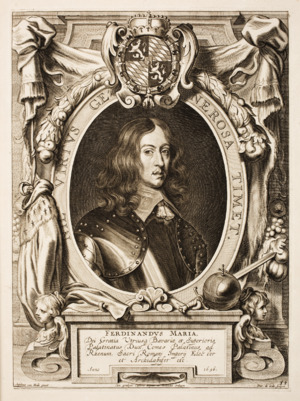Ferdinand Maria, Elector of Bavaria facts for kids
Quick facts for kids Ferdinand Maria |
|
|---|---|

Portrait by Paul Mignard
|
|
| Elector of Bavaria | |
| Reign | 27 September 1651 – 26 May 1679 |
| Predecessor | Maximilian I |
| Successor | Maximilian II Emanuel |
| Born | 31 October 1636 Schleissheim Palace, Bavaria |
| Died | 26 May 1679 (aged 42) Schleissheim Palace, Bavaria |
| Burial | June 1679 Theatiner Church, Bavaria |
| Spouse | |
| Issue |
|
| House | Wittelsbach |
| Father | Maximilian I, Elector of Bavaria |
| Mother | Maria Anna of Austria |
| Religion | Roman Catholicism |
Ferdinand Maria (born October 31, 1636 – died May 26, 1679) was an important ruler of Bavaria. He belonged to the House of Wittelsbach, a powerful royal family. From 1651 to 1679, he was an elector (a special prince who could vote for the Holy Roman Emperor) in the Holy Roman Empire.
Contents
Becoming a Prince and Elector
Ferdinand Maria was born in Munich, a city in Bavaria. He was the oldest son of Maximilian I, Elector of Bavaria, who was the ruler before him. His mother was Maria Anna of Austria, whose father was the emperor Ferdinand II, Holy Roman Emperor.
Since he was born while his father was still ruling, Ferdinand Maria was known as the Electoral Prince from birth. This meant he was next in line to become Elector. He was also a cousin to important people like Mariana of Austria, who became Queen of Spain.
In 1650, when he was 14, he married Princess Henriette Adelaide of Savoy. She was the daughter of Victor Amadeus I, Duke of Savoy. Ferdinand Maria and Henriette Adelaide had seven children together.
Ferdinand Maria's Time as Elector
When Ferdinand Maria's father died in 1651, Ferdinand Maria was still a teenager. So, his mother became his guardian. His uncle, Albert VI of Bavaria, helped rule Bavaria for three years.
Ferdinand Maria officially became Elector on October 31, 1654. He ruled with a very strong, central power, which was a new style of leadership for Germany at the time. He made an alliance with France. However, he chose not to try to become the Holy Roman Emperor himself in 1657. This was to avoid problems with the powerful House of Habsburg family.
Ferdinand Maria did help the Habsburgs in their wars against the Ottoman Empire from 1662 to 1664. Later, during the Franco-Dutch War (1672–1678), Bavaria stayed officially neutral. There were even talks about starting a Bavarian colony near New York, but these plans were soon dropped.
His oldest daughter, Maria Anna Victoria of Bavaria, married her cousin, le Grand Dauphin of France, in 1680. This marriage was a result of Bavaria's alliance with France. Ferdinand Maria was also the great-grandfather of King Louis XV of France.
What Ferdinand Maria Achieved
Ferdinand Maria did many good things for Bavaria. He made the Bavarian army stronger and more modern. He also created the first local government rules for Bavaria.
He worked hard to fix the damage caused by the Thirty Years' War. He encouraged farming and new industries. He also built or repaired many churches and monasteries. In 1669, he brought back the meeting of the diet, which was like a parliament. This meeting had not happened since 1612. When he died, he left Bavaria with a very rich treasury.
Ferdinand Maria died at the Old Schleissheim Palace. His son, Maximilian II Emanuel, Elector of Bavaria, became the next Elector. Ferdinand Maria was buried in the Theatiner Church in Munich.
Cultural Legacy and Buildings
Ferdinand Maria's marriage to Princess Henriette Adelaide of Savoy in 1650 brought the beautiful Italian Baroque style to Bavaria.
The Theatiner Church in Munich was started in 1663. It was built to thank God for the birth of their son, Prince Maximilian II Emanuel, who they had waited for a long time. After that, in 1664, Ferdinand Maria and his wife ordered the building of the Nymphenburg Palace near Munich. This palace was designed in the grand Baroque style by an Italian architect named Agostino Barelli.
Ferdinand Maria bought Lake Starnberg. This lake became a popular place for court parties, with a famous fleet of Venetian gondolas. In 1676, he also ordered the building of Berg Castle on the lake's shores.
The castle was used for many celebrations. Later, it became famous for amazing parties and hunts under the rule of his sons. For the Munich Residenz, the royal palace in Munich, Ferdinand Maria ordered the creation of the Papal Rooms.
Children of Ferdinand Maria
- Maria Anna Victoria of Bavaria (1660–1690): She married Louis, Dauphin of France and had children.
- Maximilian II Emanuel, Elector of Bavaria (1662–1726): He became the next Elector of Bavaria and had children from two marriages.
- Luise Margarete Antonie of Bavaria (1663–1665): She died when she was very young.
- Ludwig Amadeus Victor of Bavaria (1665): He also died as a baby.
- Stillborn son (1666).
- Kajetan Maria Franz of Bavaria (1670): He died in infancy.
- Joseph Clemens of Bavaria (1671–1723): He became the Elector and Archbishop of Cologne. He never married.
- Violante Beatrix of Bavaria (1673–1731): She married Ferdinando de' Medici, Grand Prince of Tuscany, but they had no children.
See also
 In Spanish: Fernando María, Elector de Baviera para niños
In Spanish: Fernando María, Elector de Baviera para niños



